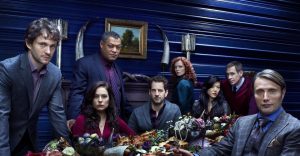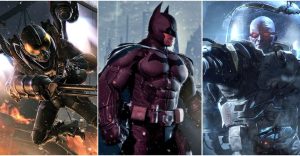Joker Easter Eggs, Cameos & DC Comics References
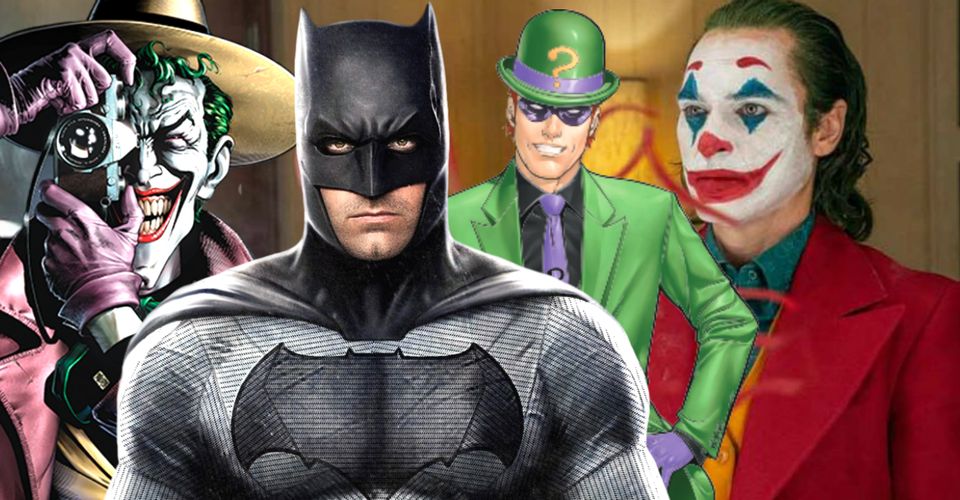
Warning! Major SPOILERS for Joker ahead.
Joker may be a standalone movie, but the film is absolutely packed with Easter eggs. In an age of cinematic universes, DC Films is taking a refreshing and very different approach. They’re still continuing to build their shared universe, the DCEU, but they’re also launching spinoffs – “Elseworlds” stories that allow writers and directors a chance to relax and really enjoy themselves.
Joker is the first of these movies, and it’s proving to be a remarkable success. The story is ostensibly a Joker origin story, revealing that the Clown Prince of Crime was once failed comedian Arthur Fleck. Suffering from a heady cocktail of mental illnesses, including a condition known as the Pseudobulbar Affect, Fleck gradually descends into madness – and takes Gotham with him. When the film comes to an end, though, viewers are left unsure whether everything they’ve seen “really” happened at all, or whether it was just a delusion. Although Joker‘s cast is willing to return, it feels more like a complete standalone, a tale that works best because it ends on an ambiguous note. Any sequel would ruin that, because it would necessitate pinning down just what happened in the first film.
And yet, Joker is still technically a comic book movie, and as such it’s full of Easter eggs. Director Todd Phillips goes beyond the comics, though, and slips in a lot of Easter eggs to other versions of Batman and the Joker – both big-screen and small. What’s more, Phillips is attempting to produce a comic book movie unlike any other, and as a result he also taps into the history of Hollywood. Here are the biggest Easter eggs you may have missed.
19. The Killing Joke Loosely Inspires Joker

The Joker is one of DC’s most mysterious, ambiguous villains; the comic book publisher has been wary of spelling out his origin story in detail, understanding that he works best as a sheer force of nature. For all that’s the case, though, some stories have explored the Joker’s origin before. The most famous of these is Alan Moore’s famous graphic novel The Killing Joke. This revealed that the man who became the Joker was originally an engineer who quit his job in order to become a comedian, only to fail miserably. He unwisely agreed to help a group of criminals steal from the chemical plant he used to work in, but the robbery was interrupted by Batman, and the Joker fell into a vat of chemicals. This is generally viewed as the Joker’s canonical origin story.
Todd Phillips’ Joker script draws on the basic concept of The Killing Joke, revealing that Joker was a failed comedian by the name of Arthur Fleck. At the same time, though, he presents a story that – while still intimate in style – has a scale that isn’t present in Moore’s comic. Joker is as much a Gotham City origin story as it is the true tale of the Clown Prince of Crime.
18. The King of Comedy and Robert De Niro’s Character
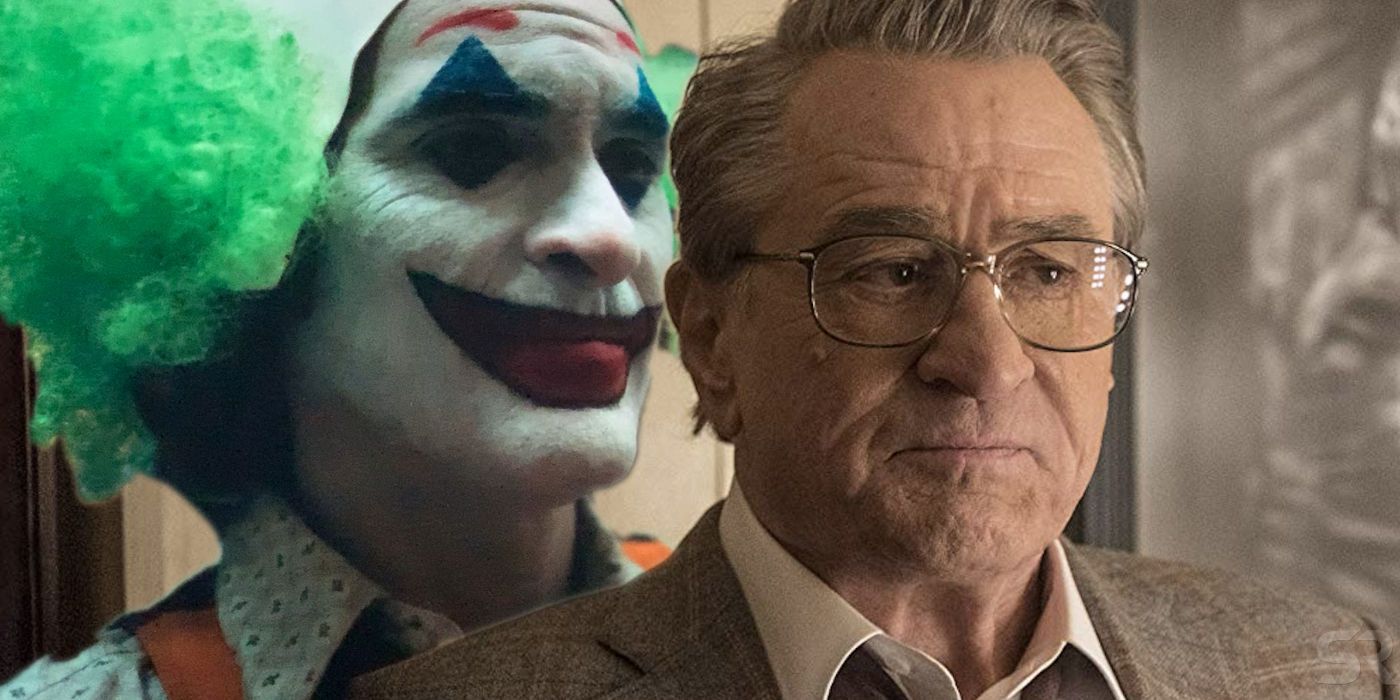
Phillips’ plot combines The Killing Joke with ideas lifted from the films of Martin Scorsese, an ironic decision given the legendary director is no lover of superhero films. The most obvious inspiration is 1983’s The King of Comedy, in which Robert De Niro played aspiring comedian Rupert Pupkin. His character became obsessed with a talk show host named Jerry Langford, played by comedy legend Jerry Lewis, and hoped one day to perform live on national television. It’s not hard to see an even more twisted version of The King of Comedy in Joker. In a wonderfully meta touch, Phillips has cast Robert De Niro himself as Murray Franklin.
17. The Joker On A Talk Show

There is actually comic book precedent for the Joker to appear on a talk show. Frank Miller’s classic Batman: The Dark Knight Returns included one scene in which the Joker was invited on national TV, reflecting one psychologist’s belief that Batman and the Joker both represented aberrant psychotic forces that were “morally bankrupt [and]politically hazardous.” It went even worse in the comics than it did in Joker; he began by kissing one of the female hosts, exposing her to a toxin he was wearing on his lips. By the time he was finished, an audience of hundreds had been killed.
16. The Joker Riots

Gotham City in Joker is a powder keg, and all it took was one lunatic with a match. Arthur Fleck is that lunatic, and soon riots blaze across Gotham City. Inspired by the mysterious clown killer, the rioters don clown masks to symbolize their agenda. These masks are reminiscent of V for Vendetta, which led to the rise of Anonymous in the real world. Who knows; perhaps soon a similar social movement will don clown masks as well. There is precedent for Joker to inspire hoodlums who wear his face as a mask. The Arkham Asylum game has exploited the idea, while Batman Beyond features the Joker gang, who all wear this kind of mask.
15. The Joker’s Costume Evokes Memories of Cesar Romero

The first live-action Joker was played by Cesar Romero, an American actor, singer, dancer, and vocal artist. He played the part for two years, and went on to reprise the role in the hilariously camp Batman movie. Joker ends with Arthur Fleck adopting a costume that’s evocative of Cesar Romero’s incarnation; while the color scheme is traditional for the Joker, the cut of the suit is a deliberate homage. Of course, tonally the two versions of the Joker couldn’t be more different.
14. A Jack Nicholson Easter Egg On A Poster

In 1989, Tim Burton’s Batman reinvented the Dark Knight for the big screen, and transformed the entire franchise. It featured one of the most iconic portrayals of the Joker, played by Jack Nicholson, and it’s fitting that Joker includes a gentle nod to Nicholson’s version. One third-act scene sees Arthur Fleck wait in a dressing-room for the Murray show. Look closely at the background, and there’s a poster on the wall showing Murray’s face – but designed in a creepy, Joker-esque style, with hair brushed back and a macabre, unnatural grin. It certainly resembles Nicholson’s look, especially when viewed through a mirror.
13. The Bloody Lips Are Reminiscent of Heath Ledger’s Joker

The Joker may have a rich history on the big screen, but Heath Ledger’s portrayal has been seen as definitive since 2008. The actor tragically died of a drug overdose shortly after playing the part in The Dark Knight, and received a posthumous Oscar for his performance. Naturally, Joker contains a Heath Ledger Easter egg, in a scene where the Joker realizes his lipstick has rubbed off. He swabs blood out of his cheeks and uses that to create a new red, a sweeping smile that’s an almost perfect match for Ledger’s bloody scar effect.
12. The Joker’s Hideout On Amusement Mile
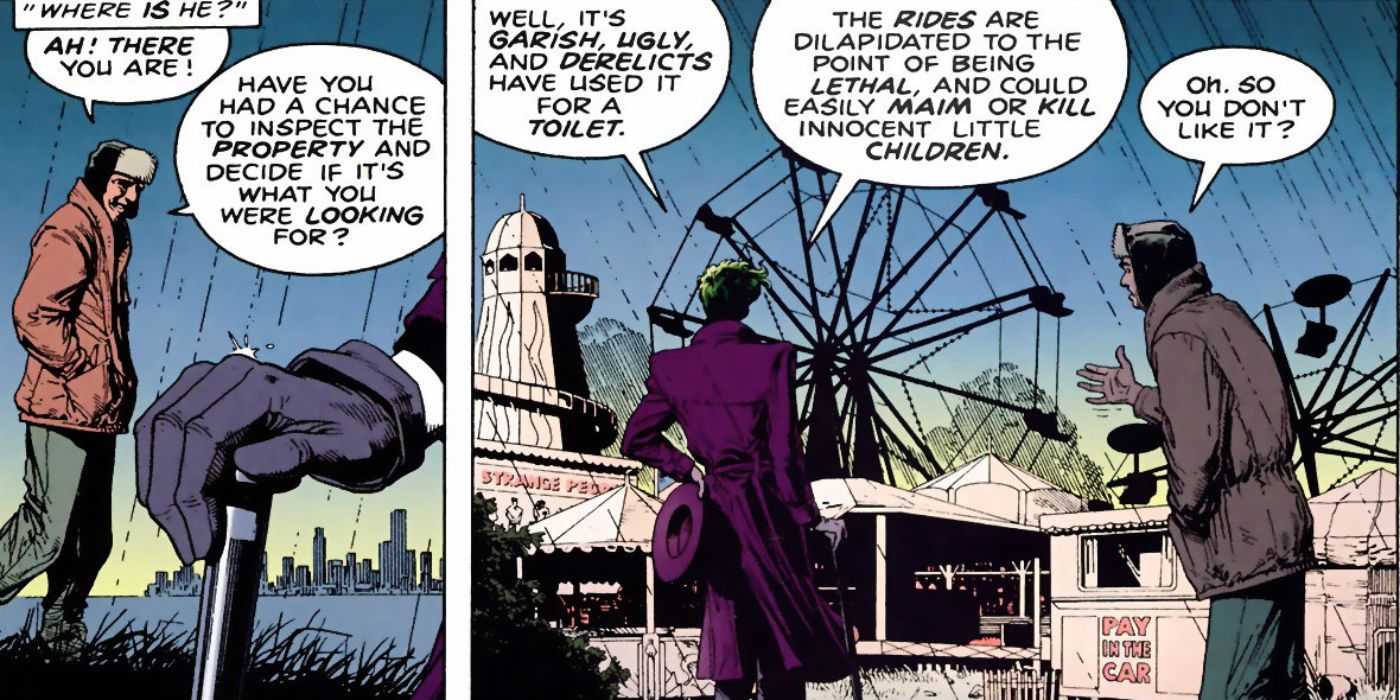
Arthur Fleck frequents one particular district of Gotham City, which can be identified by graffiti on the walls; it’s called “Amusement Mile.” This is an important Easter egg, referencing The Killing Joke, where the Joker established himself at an amusement park known as Amusement Mile. Perhaps the park is actually part of the district. Given the state of Gotham City in Joker, it’s safe to say that it’s already been shut down.
11. Arkham State Hospital

Arthur Fleck’s attempt to uncover his own family history inevitably takes him to Arkham State Hospital. In the comics, Arkham Asylum is one of the most important locations in Gotham; Batman’s rogues’ gallery include a whole lot of lunatics, and most of them have been consigned to Arkham Asylum at one time or another. The final scenes of Joker suggest that Arthur has now committed himself to a new life, one in which he commits an atrocity, winds up incarcerated in Arkham, breaks out and goes on the run.
10. Joker Has A Subtle Riddler Easter Egg

Arthur Fleck’s visit to Arkham Asylum sees him take an escalator to the basement in order to check his mother’s records. The wall of the elevator is covered in green scrawl, including a massive question mark. That’s most likely a reference to the Riddler, a classic Batman villain who’s well-known for his love of the color green and his obsession with question marks. The Riddler is also a frequent Arkham inmate, so this is an entirely appropriate place to have a Riddler Easter egg.
9. Joker Has A Ratcatcher Easter Egg

Another surprising Easter egg in Joker references a lesser-known Batman villain called the Ratcatcher. In the comics, Otis Flannegan was one of Gotham’s most successful ratcatchers before he committed himself to a life of crime. He was particularly well known for controlling unusually intelligent rats, and Joker offers an explanation for their intelligence. A long-running garbage strike means trash is accumulating on the streets of Gotham, and the city has a rat infestation. One news broadcast reveals that Gotham is now facing a plague of so-called “Super Rats,” and the broadcasters play it as a joke, suggesting the city needs to breed some “Super Cats.” Presumably, Ratcatcher winds up leading Gotham’s Super Rats, rather than just the normal variety of vermin.
8. Enter Bruce Wayne – On The Batpole

Joker sees Arthur Fleck contemplate the possibility that he could secretly be a member of the Wayne family, and at one point he heads to Wayne Manor in the hopes of meeting with Thomas Wayne. Instead, he has an unexpected encounter with Bruce Wayne, his potential “brother.” Bruce is playing in the garden, and has a pole attached to a tree-house. He spins down it in exactly the same minor Burt Ward used to spin down the Batpole in the 1960s Batman TV series.
7. Joker’s Social Worker Debra Kane

Joker’s social worker, played by Sharon Washington, is wearing a badge that identifies her as “Debra Kane.” The surname is a reference to Bob Kane, the comic book writer who came up with the idea for Batman. Because of a contractual arrangement between Kane and DC, he can be the only credited creator of the Dark Knight, so the credits tend to say that Batman was “created by Bob Kane with Bill Finger.” Interestingly, Debra Kane is something of a deep cut into DC lore herself; in Andrew Vachss’ novel Batman: The Ultimate Evil, she was a social worker who worked with children. The book is darker than most superhero fare, with Vachss taking the opportunity to explore the real-world issues of child sex tourism.
6. Joker Uses Some Very Familiar Locations

Early on in the film, Joker strolls down a street towards a bank, and a street sign identifies the location as William Street. This is a pretty deep cut into Batman lore, because William Street has been used in earlier Batman films. Batman Forever used it to double for Gotham City’s architecture, and The Dark Knight Rises staged many of its best fight scenes – including the Wall Street chase – on William Street. Phillips’ decision to reuse the location helps create a strange sense of continuity for viewers; this may be a different Joker, but the city is still the same, eerily familiar.
5. Pogo’s Is A Disturbing Easter Egg

In Joker, Arthur Fleck frequents and later performs at a comedy club called Pogo’s. This company isn’t part of Batman lore at all; it’s a reference to John Wayne Gacy, one of America’s most notorious serial killers. A clown by trade, “Pogo” was Gacy’s stage name, and he was mostly known for asphyxiating and strangling his victims. Gacy is known to have raped, tortured, and murdered at least 33 teenage boys and young men between 1972 and 1978.
4. The Murray Franklin Show Links To Batman: The Animated Series

Batman is a star of the small screen as well as the big, and Joker contains a subtle nod to the ever-popular Batman: The Animated Series. The sign for the Murray Show is actually a pretty cool Easter egg, written in a font that will be disturbingly familiar to anyone who grew up with that animated show. It’s the font from the logo.
3. Film Signs Reveal That Joker Is Set In 1981

While Joker is clearly set in the past, it’s difficult to precisely date it – until you cast an eye to the film titles. While Joker is making his presence felt on the Murray Show, clown-inspired riots rage through Gotham City. The Wayne family are leaving the cinema at the time, and the marquee shows three films that were all released in 1981 – Blow Out, Zorro the Gay Blade, and Excalibur.
Excalibur is an important reference, because it’s had a major presence in the DCEU. A flashback scene in Batman V Superman: Dawn of Justice showed an Excalibur poster in the background when the Waynes were killed. That movie went on to serve as a major source of inspiration for James Wan’s Aquaman, too. Meanwhile, it’s reasonable to assume that the Wayne family had just been to see Zorro the Gay Blade, given every previous version of the Dark Knight has been orphaned after going to watch a Zorro film with his parents.
2. Justin Theroux, Bryan Callen and Todd Phillips Have Cameos

Director Todd Phillips has a cameo of sorts; he plays the comedian who precedes Arthur Fleck at the comedy club, telling an off-color sexist joke. His face isn’t seen, but the director’s voice is quite distinctive, making this quite an amusing bit part.
Meanwhile, Phillips has a history of working with both Justin Theroux and Bryan Callen, and as a result he casts them both for minor roles in Joker as well. Justin Theroux plays a guest on the Murray Show, who Arthur Fleck watches on TV and imitates, imagining himself in his place. Bryan Callen is one of Arthur’s co-workers, and he may have originally had a larger role; in one interview he mentioned playing an aging stripper.
1. Crew Credits Appear In Joker As Well
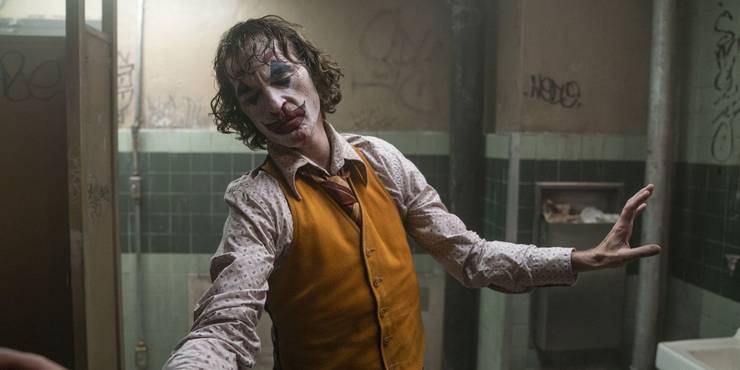
Finally, in one scene Arthur Fleck dances in front of the TV as the theme music of the Murray Show plays. The TV screen shows credits – and the names are real members of the production team. They include Ben Gatollari (assistant production coordinator), Will Limpert (production secretary), and Michael Auszura (assistant art director).
- Birds of Prey (And the Fantabulous Emancipation of One Harley Quinn) (2020)Release date: Feb 07, 2020
- Wonder Woman 1984 (2020)Release date: Dec 25, 2020
- The Batman (2022)Release date: Mar 04, 2022
- The Suicide Squad (2021)Release date: Aug 06, 2021
- DC League of Super-Pets (2022)Release date: Jul 29, 2022
- Aquaman and the Lost Kingdom (2023)Release date: Mar 17, 2023
About The Author











